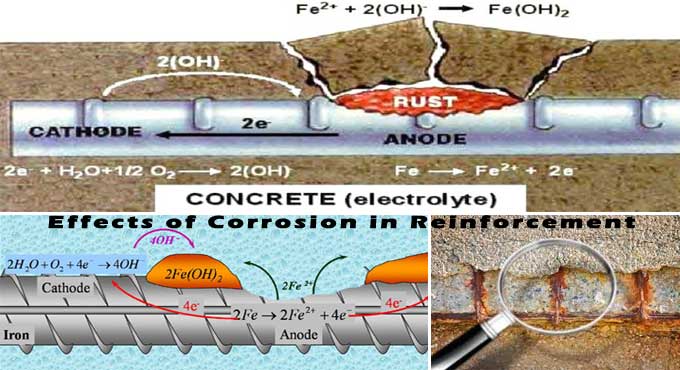NEWS | SOFTWARE | SHEET
The best way to Prevent Reinforcement Corrosion on the Construction Site
Corrosion of steel bars can have severe detrimental effects on reinforced concrete elements, undermining their serviceability and even causing structural failure. On construction sites, steel bars can be protected from corrosion by taking various precautions.
In order to control different corrosion mechanisms, concrete with high quality and low permeability is essential. In conclusion, although conventional concrete is not fully impermeable, paying proper attention to various different aspects of construction, such as manufacturing, mixing, and curing can ensure excellent quality concrete with low permeability.
To protect against reinforcement corrosion, designers and site engineers need to take these practical measures.
Prevention Methods of Reinforcement Corrosion in Construction Site
Cement Content: It is suggested that a minimum cement content of 356 kg per meter cube could be used for environments that are corrosive.
When cement content is improved, carbon-di-oxide and chlorine have a higher binding capacity. As a result, the water cement ratio, curing, and compaction quality will have a greater effect on chloride and carbonation penetration than cement content if cement is raised without analysis.
Water Cement Ratio: It is possible to produce low permeability concrete by using a low water-cement ratio, which, in turn, can provide better reinforcement protection. An external source of chlorides from deicing chemicals, salt, brackish water, seawater, or spray from these sources, or moisture, is defined as structural concrete with a maximum water-cement ratio of .40 and a minimum concrete strength of 35 MPa.
As a result, it is recommended to use a concrete strength of 42 MPa when the concrete surface is expected to degrade severely over time.
Cement Quality: Concrete durability is greatly affected by cement composition. The corrosion resistance of Portland cement increases as the content of tricalcium aluminate, also known as C3A, increases.
Cement paste is insoluble in salt due to the reaction between chloride ions and hydrated tricalcium sulfoaluminate.
If C3A reacts only with specific quantities of chloride, then its effectiveness drops when chloride content increases. As a result of improving C3A content, concrete resistance to sulfate attack is reduced.
Pozzolans: Concrete made from pozzolanic materials such as silica fume, blast furnace slag, and fly ash resists chloride and sulfate attacks. Water and calcium hydroxide are combined with pozzolans to produce concrete that is both low-permeable and highly durable.
Admixture: Steel reinforcement is protected from corrosion by chemical additives. Water reducing admixtures and super plasticizers provide proper workability, improving impermeability by reducing water content. A mixture containing calcium chloride should be avoided because it can cause corrosion to steel.
Aggregate: Around 70 percent of the volume of concrete is composed of aggregates, which affect concrete permeability greatly.
As the coarse aggregate size increases, concrete permeability increases. Compared to concrete paste, mineral aggregates have a 10 to 1000 times greater permeability. Therefore, water-cement ratio calculations should include aggregate moisture content, and aggregates should be washed.
Amount of Chloride: Weather conditions, construction locations, and many other factors determine the maximum chloride ion content in concrete.
Concrete Cover Thickness: Corrosion of reinforcement is largely determined by the depth of the concrete cover. Additional concrete cover can delay moisture penetration and chloride ingression. Reinforcement corrosion is influenced by several parameters, including concrete cover thickness.
To get more details, watch the following video tutorial.
Lecturer: Cortec Middle East
Compaction: The degree of concrete compaction directly affects reinforcement corrosion. When concrete poured is not adequately compacted, concrete elements will corrode more rapidly. A ten percent decrease in compaction increases permeability by hundred percent and reduces concrete strength by fifty percent. Clearly, compaction adequacy plays a crucial role in corrosion prevention.
Curing: It is possible to reduce concrete permeability by properly curing and controlling both temperature and moisture. In the absence of adequate curing, the concrete surface layer becomes five to ten times more porous. The chloride ions will enter the concrete before the passive protective film is formed if the curing period is too short.
Crack Width Limitation: Reinforcement corrosion is significantly affected by concrete cracks. On the tension side of the element that is exposed to wetting and drying, a crack width of .15 mm is acceptable.
A longitudinal crack in steel reinforcement is also found to be much more detrimental than a crack perpendicular to the longitudinal reinforcement. Due to the latter's small ingress area & the former's potential to spill off the concrete cover, the latter is preferable.
Coating for Protection: Another method of preventing corrosion is by coating reinforcement bars and applying cathode protection. The cost of these products is higher than that of low-permeable concrete protection.
Protection by coatings is primarily achieved through anodic and barrier coatings. By using volunteering anodes or directing ion flow away from the reinforcement, the cathode technique changes the concrete environment.


